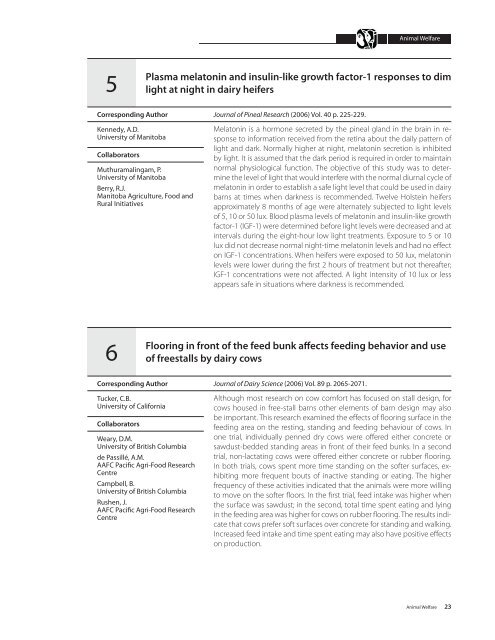A52-75-2007E.pdf - AgroMedia International Inc
A52-75-2007E.pdf - AgroMedia International Inc
A52-75-2007E.pdf - AgroMedia International Inc
Create successful ePaper yourself
Turn your PDF publications into a flip-book with our unique Google optimized e-Paper software.
Animal Welfare5Plasma melatonin and insulin-like growth factor-1 responses to dimlight at night in dairy heifersCorresponding AuthorKennedy, A.D.University of ManitobaCollaboratorsMuthuramalingam, P.University of ManitobaBerry, R.J.Manitoba Agriculture, Food andRural InitiativesJournal of Pineal Research (2006) Vol. 40 p. 225-229.Melatonin is a hormone secreted by the pineal gland in the brain in responseto information received from the retina about the daily pattern oflight and dark. Normally higher at night, melatonin secretion is inhibitedby light. It is assumed that the dark period is required in order to maintainnormal physiological function. The objective of this study was to determinethe level of light that would interfere with the normal diurnal cycle ofmelatonin in order to establish a safe light level that could be used in dairybarns at times when darkness is recommended. Twelve Holstein heifersapproximately 8 months of age were alternately subjected to light levelsof 5, 10 or 50 lux. Blood plasma levels of melatonin and insulin-like growthfactor-1 (IGF-1) were determined before light levels were decreased and atintervals during the eight-hour low light treatments. Exposure to 5 or 10lux did not decrease normal night-time melatonin levels and had no effecton IGF-1 concentrations. When heifers were exposed to 50 lux, melatoninlevels were lower during the first 2 hours of treatment but not thereafter;IGF-1 concentrations were not affected. A light intensity of 10 lux or lessappears safe in situations where darkness is recommended.6Flooring in front of the feed bunk affects feeding behavior and useof freestalls by dairy cowsCorresponding AuthorTucker, C.B.University of CaliforniaCollaboratorsWeary, D.M.University of British Columbiade Passillé, A.M.AAFC Pacific Agri-Food ResearchCentreCampbell, B.University of British ColumbiaRushen, J.AAFC Pacific Agri-Food ResearchCentreJournal of Dairy Science (2006) Vol. 89 p. 2065-2071.Although most research on cow comfort has focused on stall design, forcows housed in free-stall barns other elements of barn design may alsobe important. This research examined the effects of flooring surface in thefeeding area on the resting, standing and feeding behaviour of cows. Inone trial, individually penned dry cows were offered either concrete orsawdust-bedded standing areas in front of their feed bunks. In a secondtrial, non-lactating cows were offered either concrete or rubber flooring.In both trials, cows spent more time standing on the softer surfaces, exhibitingmore frequent bouts of inactive standing or eating. The higherfrequency of these activities indicated that the animals were more willingto move on the softer floors. In the first trial, feed intake was higher whenthe surface was sawdust; in the second, total time spent eating and lyingin the feeding area was higher for cows on rubber flooring. The results indicatethat cows prefer soft surfaces over concrete for standing and walking.<strong>Inc</strong>reased feed intake and time spent eating may also have positive effectson production.Animal Welfare 23





